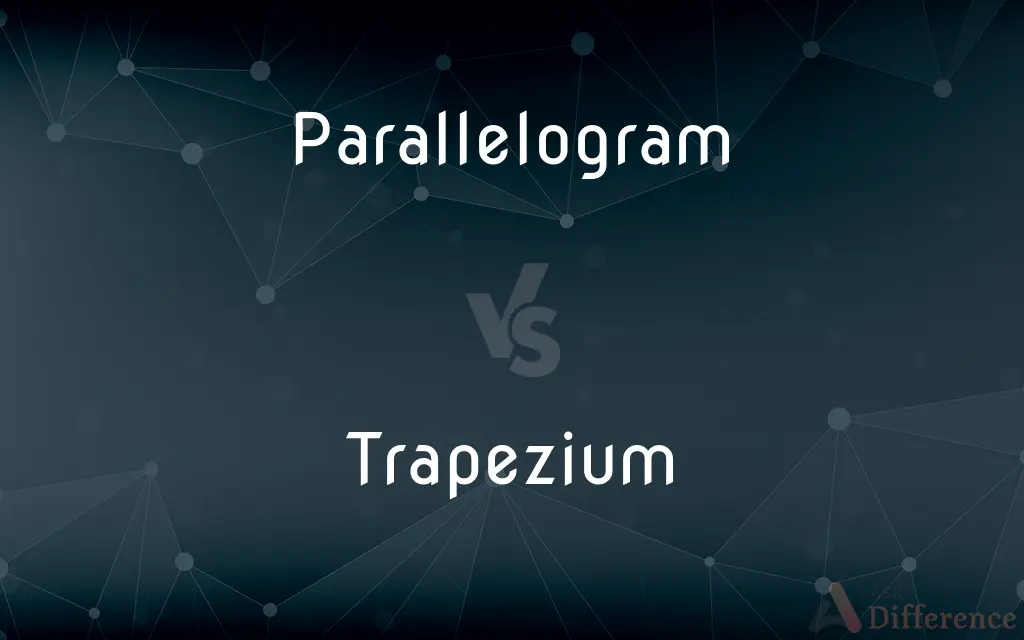Parallelogram vs. Trapezium — What's the Difference?
By Tayyaba Rehman — Updated on October 12, 2023
A "parallelogram" is a quadrilateral with opposite sides parallel; a "trapezium" (U.S. definition) is a quadrilateral with no parallel sides.

Difference Between Parallelogram and Trapezium
Table of Contents
ADVERTISEMENT
Key Differences
A "parallelogram" is a specific type of four-sided figure in geometry where both pairs of opposite sides are parallel. In contrast, a "trapezium," as defined in the U.S., is a quadrilateral with no parallel sides.
In a "parallelogram," opposite angles are always equal, and the opposite or facing sides have equal lengths. A "trapezium" doesn't share these specific properties, as it can have varied angles and side lengths.
Due to the parallel nature of its sides, a "parallelogram" has a unique property where the sum of the squares of the lengths of the diagonals equals twice the sum of the squares of the lengths of the sides. On the other hand, a "trapezium" lacks such a specific characteristic.
Area calculation for a "parallelogram" is base times height, which remains consistent for all parallelograms. In contrast, the area of a "trapezium" is calculated as the average of the lengths of the bases multiplied by the height, which can vary due to its lack of parallel sides.
A rectangle and square are special cases of a "parallelogram" where all angles are right angles, with a square having all sides equal. A "trapezium" does not encompass these specialized quadrilaterals because of its definition regarding parallel sides.
ADVERTISEMENT
Comparison Chart
Parallel Sides
Both pairs of opposite sides are parallel.
No parallel sides.
Angle Properties
Opposite angles are equal.
Angles can vary.
Diagonal Properties
Sum of squares of diagonals has a specific relationship to sides.
Lacks this specific relationship.
Area Calculation
Area = base x height.
Area varies due to lack of parallel sides.
Special Cases
Includes rectangles and squares.
Does not include these shapes.
Compare with Definitions
Parallelogram
Shape where opposite sides have equal lengths.
In a parallelogram, if one side is 5 cm, the opposite side will also be 5 cm.
Trapezium
Shape with varied side lengths.
A trapezium can have sides of different lengths, adding to its diversity.
Parallelogram
A shape where the consecutive angles are supplementary.
In a parallelogram, if one angle measures 80 degrees, its adjacent angle will measure 100 degrees.
Trapezium
A four-sided figure without specific angle measurements.
The angles in a trapezium can vary widely.
Parallelogram
Quadrilateral with equal opposite angles.
The opposite angles in a parallelogram are always congruent.
Trapezium
A quadrilateral with no parallel sides.
In the U.S., a trapezium is a diverse shape without restrictions on its angles or sides.
Parallelogram
Diagonals bisect each other.
The point where the diagonals of a parallelogram intersect divides each diagonal into two equal parts.
Trapezium
Quadrilateral that doesn't fit the definitions of other specialized shapes.
If a four-sided shape isn't a rectangle, square, parallelogram, or rhombus, it could be a trapezium.
Parallelogram
A four-sided figure with opposite sides parallel.
A rectangle is a type of parallelogram with right angles.
Trapezium
A non-specialized quadrilateral.
A trapezium is a basic four-sided shape without the constraints of other quadrilaterals.
Parallelogram
In Euclidean geometry, a parallelogram is a simple (non-self-intersecting) quadrilateral with two pairs of parallel sides. The opposite or facing sides of a parallelogram are of equal length and the opposite angles of a parallelogram are of equal measure.
Trapezium
A quadrilateral having no parallel sides.
Parallelogram
A four-sided plane figure with opposite sides parallel.
Trapezium
Chiefly British A trapezoid.
Parallelogram
(geometry) A convex quadrilateral in which each pair of opposite edges are parallel and of equal length.
Trapezium
(Anatomy)A bone in the wrist at the base of the thumb.
Parallelogram
Either of two rectangular areas (respectively the large parallelogram and the small parallelogram) abutting the goal line in front of the goal. (Since 1986 officially named the large rectangle and small rectangle, though the older names are still occasionally used.)
Trapezium
A quadrilateral with two sides parallel.
Parallelogram
A right-lined quadrilateral figure, whose opposite sides are parallel, and consequently equal; - sometimes restricted in popular usage to a rectangle, or quadrilateral figure which is longer than it is broad, and with right angles.
Trapezium
(restrictively) A quadrilateral with two sides parallel and two sides non-parallel.
Parallelogram
A quadrilateral whose opposite sides are both parallel and equal in length
Trapezium
A four-sided polygon with no parallel sides and no sides equal; a simple convex irregular quadrilateral.
Trapezium
(anatomy) The trapezium bone of the wrist.
Trapezium
A region on the ventral side of the brain, either just back of the pons Varolii, or, as in man, covered by the posterior extension of its transverse fibers.
Trapezium
A plane figure bounded by four right lines, of which no two are parallel.
Trapezium
A bone of the carpus at the base of the first metacarpal, or thumb.
Trapezium
A quadrilateral with no parallel sides
Trapezium
A multiple star in the constellation of Orion
Trapezium
The wrist bone on the thumb side of the hand that articulates with the 1st and 2nd metacarpals
Common Curiosities
How do the diagonals of a "parallelogram" behave?
They bisect each other.
What defines a "parallelogram"?
A parallelogram has both pairs of opposite sides parallel.
How does the U.S. define a "trapezium"?
In the U.S., a trapezium is a quadrilateral with no parallel sides.
Are all sides in a "parallelogram" equal?
Not necessarily, only opposite sides are equal.
What are the angle properties of a "trapezium"?
They can vary and don't have specific constraints.
How is the area of a "trapezium" calculated?
It varies due to its lack of parallel sides.
Can a "trapezium" have one pair of parallel sides?
Not in the U.S.; that would be a trapezoid.
Is every rectangle a "parallelogram"?
Yes, every rectangle is a parallelogram with right angles.
Are the opposite angles of a "parallelogram" always equal?
Yes, they are.
Share Your Discovery

Previous Comparison
Duplicate vs. Copy
Next Comparison
Mauve vs. PinkAuthor Spotlight
Written by
Tayyaba RehmanTayyaba Rehman is a distinguished writer, currently serving as a primary contributor to askdifference.com. As a researcher in semantics and etymology, Tayyaba's passion for the complexity of languages and their distinctions has found a perfect home on the platform. Tayyaba delves into the intricacies of language, distinguishing between commonly confused words and phrases, thereby providing clarity for readers worldwide.
















































